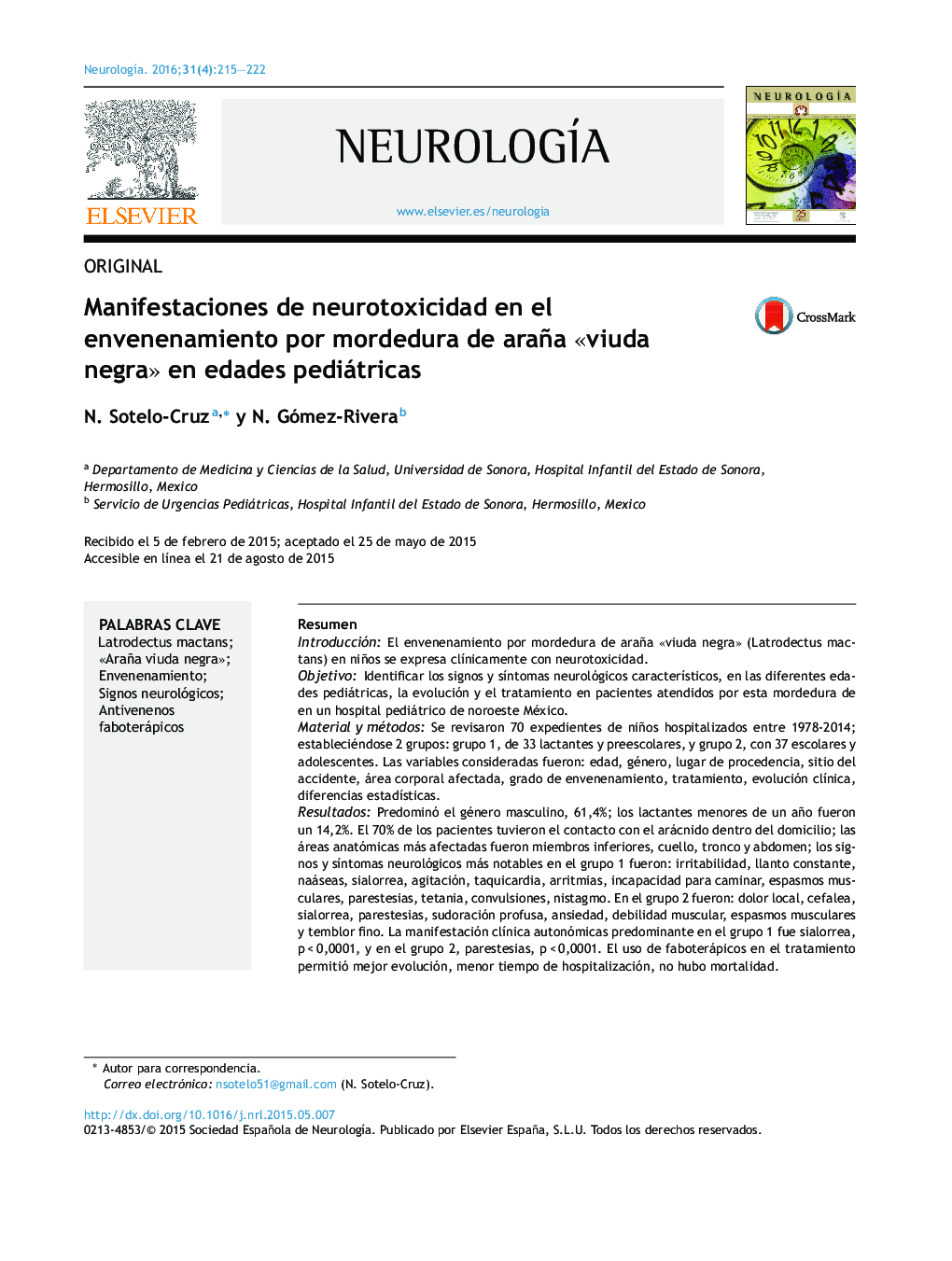| Article ID | Journal | Published Year | Pages | File Type |
|---|---|---|---|---|
| 3075685 | Neurología | 2016 | 8 Pages |
ResumenIntroducciónEl envenenamiento por mordedura de araña «viuda negra» (Latrodectus mactans) en niños se expresa clínicamente con neurotoxicidad.ObjetivoIdentificar los signos y síntomas neurológicos característicos, en las diferentes edades pediátricas, la evolución y el tratamiento en pacientes atendidos por esta mordedura de en un hospital pediátrico de noroeste México.Material y métodosSe revisaron 70 expedientes de niños hospitalizados entre 1978-2014; estableciéndose 2 grupos: grupo 1, de 33 lactantes y preescolares, y grupo 2, con 37 escolares y adolescentes. Las variables consideradas fueron: edad, género, lugar de procedencia, sitio del accidente, área corporal afectada, grado de envenenamiento, tratamiento, evolución clínica, diferencias estadísticas.ResultadosPredominó el género masculino, 61,4%; los lactantes menores de un año fueron un 14,2%. El 70% de los pacientes tuvieron el contacto con el arácnido dentro del domicilio; las áreas anatómicas más afectadas fueron miembros inferiores, cuello, tronco y abdomen; los signos y síntomas neurológicos más notables en el grupo 1 fueron: irritabilidad, llanto constante, naáseas, sialorrea, agitación, taquicardia, arritmias, incapacidad para caminar, espasmos musculares, parestesias, tetania, convulsiones, nistagmo. En el grupo 2 fueron: dolor local, cefalea, sialorrea, parestesias, sudoración profusa, ansiedad, debilidad muscular, espasmos musculares y temblor fino. La manifestación clínica autonómicas predominante en el grupo 1 fue sialorrea, p < 0,0001, y en el grupo 2, parestesias, p < 0,0001. El uso de faboterápicos en el tratamiento permitió mejor evolución, menor tiempo de hospitalización, no hubo mortalidad.ConclusionesLos signos y los síntomas de la mordedura por araña «viuda negra» son predominantemente autonómicos; identificarlos permite el diagnóstico oportuno y tratamiento eficaz.
IntroductionEnvenomation by black widow spiders manifests clinically with signs of neurotoxicity in paediatric patients.ObjectiveIdentify typical neurological signs and symptoms in paediatric patients of different ages, and describe treatment and outcomes in a paediatric hospital in northwest Mexico.Material and methodsWe reviewed 70 clinical records of patients hospitalised due to black widow spider bite between 1978 and 2014. We divided the total into 2 groups: Group 1, infants and preschool children; and Group 2, school-age children and adolescents. The demographic variables were age, sex, birthplace, place where envenomation occurred, body part(s) affected, degree of envenomation according to signs and symptoms, treatment, clinical outcome, and statistical differences.ResultsBoys accounted for 61.4% of all cases, and infants younger than one year old made up 14.2%. Most patients (70%) were bitten by the spider at home; the anatomical areas most frequently affected were the legs, neck, thorax, and abdomen. The neurological signs and symptoms displayed by Group 1 were irritability, constant crying, sialorrhoea, nausea, tachycardia, arrhythmias, fatigue when walking, agitation, muscle spasms paraesthesia, tetany, seizures, and nystagmus. Signs in Group 2 included localized pain, headache, sialorrhoea, paraesthesia, profuse sweating, anxiety, muscle weakness, muscle spasms, and fine tremor. The predominant autonomic sign in Group 1 was sialorrhoea (P<.0001) and in Group 2, paraesthesia (P<.0001). Patients who received Fab antivenom treatment displayed better outcomes and shorter hospital stays than those who did not. No deaths were reported.ConclusionsThe neurological signs and symptoms caused by black widow spider bite are predominantly autonomic, and identifying them permits early diagnosis and more effective treatment
